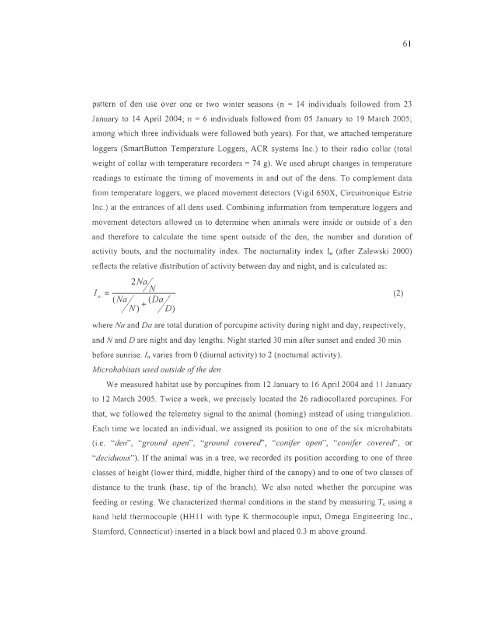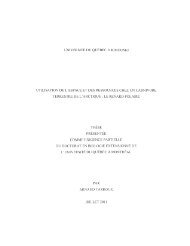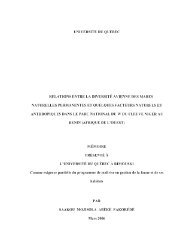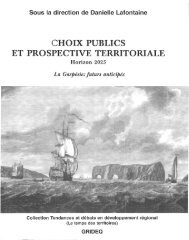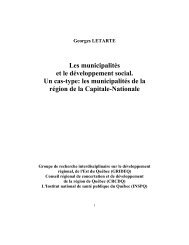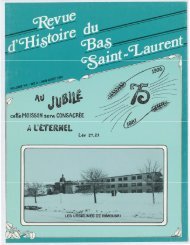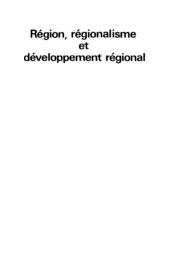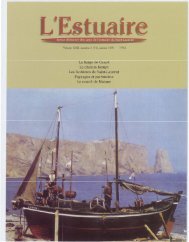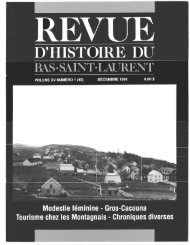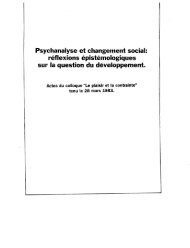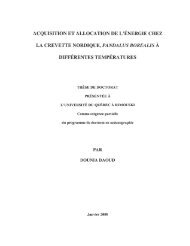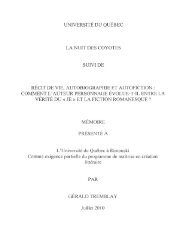influence du climat et de la prédation sur l'utilisation de l'habitat et la ...
influence du climat et de la prédation sur l'utilisation de l'habitat et la ...
influence du climat et de la prédation sur l'utilisation de l'habitat et la ...
Create successful ePaper yourself
Turn your PDF publications into a flip-book with our unique Google optimized e-Paper software.
61<br />
pattern of <strong>de</strong>n use over one or two winter seasons (n = 14 indivi<strong>du</strong>a1s followed from 23<br />
January to 14 April 2004; n = 6 indivi<strong>du</strong>als followed from 05 January to 19 March 2005;<br />
among which three indivi<strong>du</strong>als were followed both years). For that, we attached temperature<br />
loggers (SmartButton Temperature Loggers, ACR systems Inc.) to their radio col<strong>la</strong>r (total<br />
weight of col<strong>la</strong>r with temperature recor<strong>de</strong>rs = 74 g). We used abrupt changes in temperature<br />
readings to estimate the timing of movements in and out of the <strong>de</strong>ns. To complement data<br />
from temperature loggers, we p<strong>la</strong>ced movement d<strong>et</strong>ectors (Vigil 650X, Circuitronique Estrie<br />
Inc.) at the entrances of ail <strong>de</strong>ns used. Combining information from temperature loggers and<br />
movement d<strong>et</strong>ectors allowed us to d<strong>et</strong>ermine wh en animais were insi<strong>de</strong> or outsi<strong>de</strong> of a <strong>de</strong>n<br />
and therefore to ca\cu<strong>la</strong>te the time spent outsi<strong>de</strong> of the <strong>de</strong>n, the number and <strong>du</strong>ration of<br />
activity bouts, and the nocturnality in<strong>de</strong>x. The nocturnality in<strong>de</strong>x ln (after Zalewski 2000)<br />
reflects the re<strong>la</strong>tive distribution of activity b<strong>et</strong>ween day and night, and is calcu<strong>la</strong>ted as:<br />
2Nal<br />
1 = I N<br />
Il (Nal +(Dal<br />
I N) I D)<br />
(2)<br />
where Na and Da are total <strong>du</strong>ration of porcupine activity <strong>du</strong>ring night and day, respectively,<br />
and N and D are night and day lengths. Night started 30 min after sun s<strong>et</strong> and en<strong>de</strong>d 30 min<br />
before sunrise. In varies from 0 (diurnal activity) to 2 (nocturnal activity).<br />
Microhabitats used outsi<strong>de</strong> of the <strong>de</strong>n<br />
We mea<strong>sur</strong>ed habitat use by porcupines from 12 January to 16 April 2004 and Il January<br />
to 12 March 2005. Twice a week, we precisely located the 26 radiocol<strong>la</strong>red porcupines. For<br />
that, we followed the telem<strong>et</strong>ry signal to the animal (homing) instead of using triangu<strong>la</strong>tion.<br />
Each time we located an indivi<strong>du</strong>al, we assigned its position to one of the six microhabitats<br />
(i.e. "<strong>de</strong>n", "ground open", "ground covered" , "conifer open", "conifer covered" , or<br />
"<strong>de</strong>ci<strong>du</strong>ous"). If the animal was in a tree, we recor<strong>de</strong>d its position according to one of tluee<br />
c<strong>la</strong>sses of height (Iower third, middle, higher third of the canopy) and to one of two c<strong>la</strong>sses of<br />
distance to the trunk (base, tip of the branch). We also noted wh<strong>et</strong>her the porcupine was<br />
feeding or resting. We characterized thermal conditions in the stand by mea<strong>sur</strong>ing Tc using a<br />
hand held thermocouple (HH Il with type K thermocouple input, Omega Engineering Inc.,<br />
Stamford, Connecticut) inserted in a b<strong>la</strong>ck bowl and p<strong>la</strong>ced 0.3 m ab ove ground.


